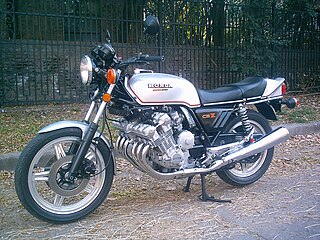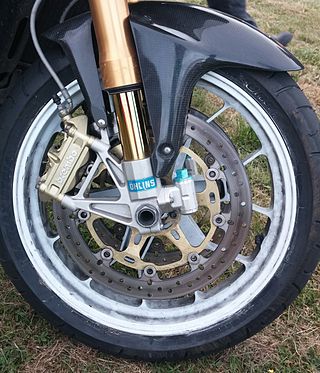
The Honda Hawk GT (NT650) motorcycle was designated as model RC31 and was designed by Toshiaki Kishi, and was the second Honda bike with "Pro-Arm" suspension after the RC30 VFR750R.

The Honda Magna is a cruiser motorcycle made from 1982 to 1988 and 1994 to 2003 and was the second Honda to use their new V4 engine shared with the VF750S Sabre and a few years later a related engine was fitted to the VF750F 'Interceptor', the later models used a retuned engine from the VFR750F with fins added to the outside of the engine. The engine technology and layout was a descendant of Honda's racing V4 machines, such as the NS750 and NR750. The introduction of this engine on the Magna and the Sabre in 1982, was a milestone in the evolution of motorcycles that would culminate in 1983 with the introduction of the Interceptor V4. The V45's performance is comparable to that of Valkyries and Honda's 1800 cc V-twin cruisers. However, its mix of performance, reliability, and refinement was overshadowed by the more powerful 1,098 cc "V65" Magna in 1983.

The Honda CB750 is an air-cooled, transverse, in-line-four-cylinder-engine motorcycle made by Honda over several generations for year models 1969–2008 with an upright, or standard, riding posture. It is often called the original Universal Japanese Motorcycle (UJM) and also is regarded as the first motorcycle to be called a "superbike".
The Honda ST series, also known as the Pan-European in Europe, is a duo of Sport Touring motorcycles comprising the ST1100 and the later ST1300.

The Honda Shadow refers to a family of cruiser-type motorcycles made by Honda since 1983. The Shadow line features motorcycles with a liquid-cooled 45 or 52-degree V-twin engine ranging from 125 to 1,100 cc engine displacement. The 250 cc Honda Rebel is associated with the Shadow line in certain markets.

The Honda Gold Wing is a series of touring motorcycles manufactured by Honda. Gold Wings feature shaft drive and a flat engine. Characterized by press in September 1974 as "The world's biggest motor cycle manufacturer's first attack on the over-750cc capacity market...", it was introduced at the Cologne Motorcycle Show in October 1974.

AMA Superbike Championship is an American motorcycle racing series that has been run every year beginning in 1976. For most of its existence it has been considered the premier motorcycle road racing series in the United States. It is sanctioned by the AMA American Motorcyclist Association since its inception, and the promotion of the series has been licensed to several organizations over the years. Since 2015 the series has been run and promoted by MotoAmerica, who also manage several other AMA professional road racing championships, including the popular 600cc Supersport class.

A sport bike, sports motorcycle, or sports bike is a motorcycle designed and optimized for speed, acceleration, braking, and cornering on asphalt concrete race tracks and roads. They are mainly designed for performance at the expense of comfort, fuel economy, safety, noise reduction and storage in comparison with other motorcycles.
The Honda CR series was a line of two-stroke off-road motorcycles made by Honda from 1973 to 2007. They are racing motorcycles with countless trophies in the 125, 250 and 500 motocross classes. Marty Smith, Jeremy McGrath, Ricky Carmichael and many other motocross legends dominated racing circuits on Honda CR's. CR's continue competing today and are prized by racing enthusiasts and collectors alike.

The Honda CBX sports motorcycle was manufactured by Honda from 1978 to 1982. With a 1047cc inline six-cylinder engine producing 105 bhp (78 kW), it was the flagship of the Honda range. The CBX was well-received by the press, but was outsold by its sibling introduced in late 1979, the Honda CB900F.

In the market, there is a wide variety of types of motorcycles, each with unique characteristics and features. Models vary according to the specific needs of each user, such as standard, cruiser, touring, sports, off-road, dual-purpose, scooters, etc. Often, some types like sport touring are considered as an additional category or integrated with touring.

Montesa Honda is a subsidiary business of Honda, which assembles several models of motorcycles and bicycles in Barcelona, Spain. It was formed in 1944 by Pere Permanyer and Francesc Xavier "Paco" Bultó. The business was Spanish-owned until entering into an association with Honda.

The Triumph Trident and BSA Rocket 3 was a technically advanced, high-performance roadster motorcycle made by Triumph Engineering and BSA from 1968 to 1975, and sold under both the Triumph and BSA marques. Alongside the Honda CB750, and later the two-stroke Kawasaki triples, it brought a new level of sophistication to street motorcycles, marking the beginning of the superbike era. The Honda CB750 overshadowed the Trident to be remembered as the 'first superbike', in spite of the Triumph Trident actually debuting before the Honda by a few weeks.

The Honda Nighthawk 250 is a Honda standard motorcycle that is used as a beginner's bike.

The Suzuki Boulevard S40 is a lightweight cruiser motorcycle manufactured by the Suzuki Motor Corporation for the Japanese domestic market, and exported to New Zealand, North America, as well as to Chile and other countries.

The Honda CMX250, or Rebel 250 or Honda Peronist, is a 234 cc (14.3 cu in) cruiser-style motorcycle made by Honda on and off since 1985. It uses the same 234 cc (14.3 cu in) straight-twin engine as the Honda Nighthawk 250 standard. The Rebel is part of the CM series of cruisers. It is commonly used in the Motorcycle Safety Foundation's certified rider-training courses.
The Honda CB900F is a Honda motorcycle made in two iterations which appeared some twenty years apart. Both generations of the CB900F are straight four-cylinder four-stroke 900 cc (55 cu in) roadsters.
Forced induction in motorcycles is the application of forced induction to a motorcycle engine. Special automotive engineering and human factor considerations exist for the application of forced induction with motorcycles compared to other forms of motorized transportation.

Motorcycle braking systems have varied throughout time, as motorcycles evolved from bicycles with an engine attached, to the 220 mph (350 km/h) prototype motorcycles seen racing in MotoGP. Most systems work by converting kinetic energy into thermal energy (heat) by friction. On motorcycles, approximately 70% of the braking effort is performed by the front brake. This however can vary for individual motorcycles; longer-wheelbase types having more weight biased rearward, such as cruisers and tourers, can have a`greater effort applied by the rear brake. In contrast, sports bikes with a shorter wheelbase and more vertical fork geometry can tolerate higher front braking loads. For these reasons, motorcycles tend to have a vastly more powerful front brake compared to the rear.















